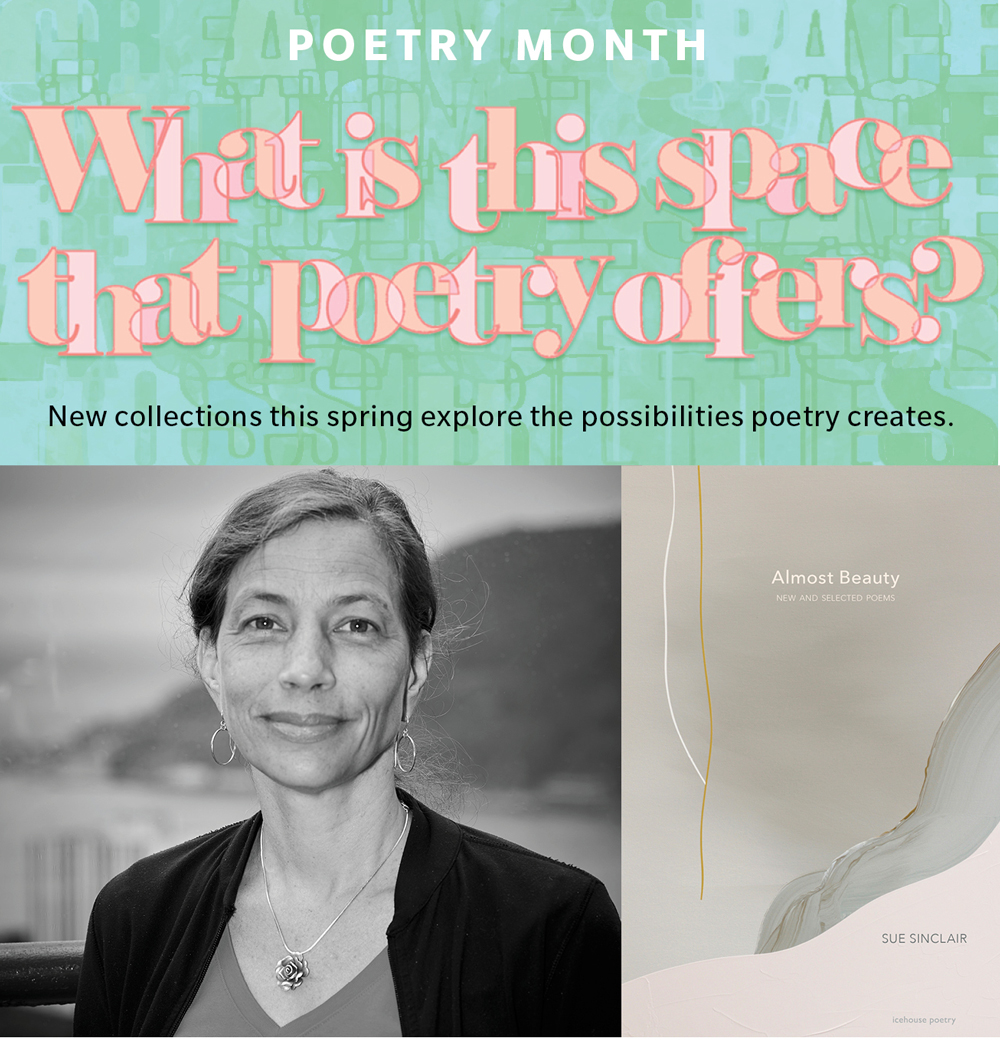“The Prado,” the opening poem in Sue Sinclair’s volume of new and selected poetry, begins, “Afterward, I asked myself what I looked for.” This line, cast as it is in retrospect, may constitute a kind of mission statement for the book, and for Sinclair’s poetic practice generally.
Almost Beauty: New and Selected Poems, published in March by Fredericton’s Goose Lane Editions, encompasses the entirety of Sinclair’s output to date, including selections from five previous collections published between 2001 and 2016, as well as a generous helping of previously uncollected poetry. Any single-volume selection of a poet’s writing is valuable for the glimpse it offers into that person’s artistic development and ongoing concerns; in Almost Beauty, the themes and ideas that pervade Sinclair’s work prove remarkably consistent across the first two decades of the 21st century.
The opening line of “The Prado” offers insight into the notion of looking and seeing, something the writer is clearly devoted to in her poetics. Sinclair teaches creative writing at the University of New Brunswick, edits the journal Fiddlehead, and serves as poetry editor for Brick Books. As a student, she worked under the tutelage of Don McKay and Jan Zwicky, both of whom she credits for inculcating a habit of close observation that finds its way into her work. “I think I carried forward from them the desire to be as deeply attentive to the world around me as I can,” she says by phone from her home in Fredericton.
Sinclair, who holds a PhD in philosophy, marshals that laser-focused attention on recognizable objects and everyday occurrences to get at deep questions about living as humans in the world. She does this through language that is sleek and unadorned, the better to communicate difficult or abstruse philosophical concepts. “I’m probably somebody who’s interested in making language accessible,” she says of her syntactic approach to poetry. “I want to look out the window that is language at the world, as opposed to poets who want the window to be weirdly foggy or frosted up in ways that make you aware of language itself, of the window itself.”
Sinclair’s radical transparency in the use of language belies the complexity of the ideas she engages with in her work. Not least among these is the notion of beauty, an abstract concept that not only gives the book its title but also informs much of Sinclair’s poetic imagination. Far from adhering to Keats’s notion of the dialectical relationship between truth and beauty, Sinclair’s work constantly questions conventional notions of how beauty operates in our world.
“I wanted to think about the ways beauty can be a lie,” Sinclair says of her ethical concerns around the subject, which she notes is often co-opted by advertising to sell things. “Beauty always seems to have this elusive quality to it.”
But, typical of a poet who constantly evaluates and reconsiders her own conceptions, no sooner has Sinclair made this declaration than she recalls friends who are adept at locating the good in others where it might not be immediately obvious. “In some moments, that can seem short-sighted to me,” Sinclair says. “In other moments, I think they have a grasp on one part of the truth. So, not a lie, but the most bearable part of the truth.”
Another of Sinclair’s ongoing poetic concerns is the environment. Whether writing about apple trees in a winter garden (“The leaves have not gone, but have changed / into thought”) or frank political critiques of New Brunswick’s Sisson Mine project, Sinclair embraces the label “ecopoet” as a term of identification. “I don’t think that’s always obvious to folks, because I’m not always writing about the climate crisis or the Anthropocene. But I am thinking deeply about the relationships of humans to the ecologies in which we participate.”
Perhaps unsurprisingly for a philosopher, this notion of relationship is key to Sinclair’s understanding of what she is doing in her ecologically motivated work, forcing her to confront questions about how humans act in regard to the natural world and what problems result from that interaction. “It’s not just that I am appreciating nature and it’s beautiful,” she says. “All those questions come up for an ecopoet in a way they might not for a traditional nature poet.”
At their core, these are ethical concerns, and Sinclair emphasizes the extent to which her own ethics inform her writing. She is careful to stipulate that her intent is not the amelioration of readers. “I feel that it would be a big claim to say that I can make readers better people,” she says. “Maybe what I could hope is that my own struggle to be an ethical person – to figure out how to be here and to be an ethical person – will help people along in their own struggles.”
Art, by Karen Taylor, is based on text from Gillian Sze’s Quiet Night Think. Sue Sinclair: Peter Sinclair

 Contact us via email
Contact us via email

